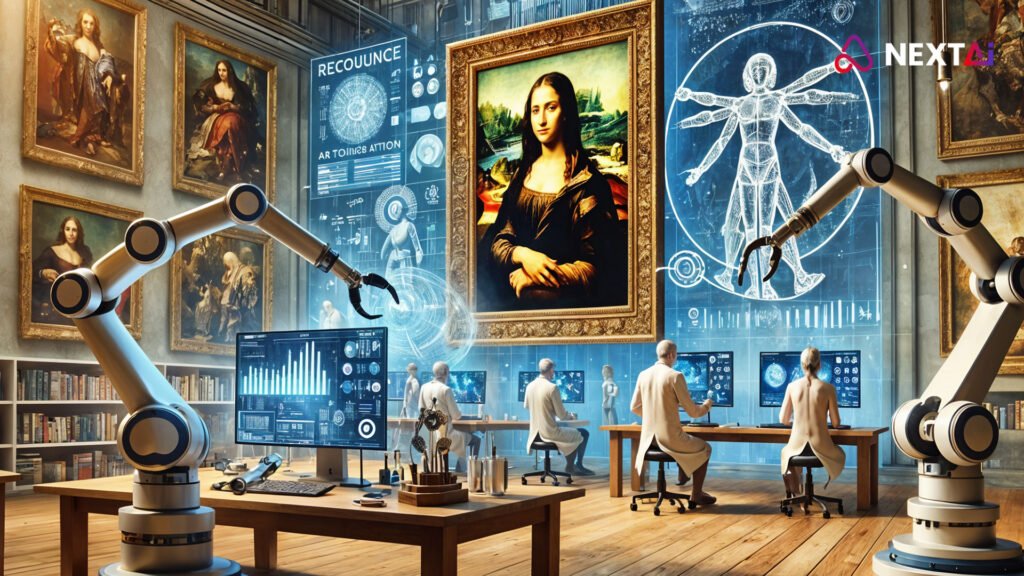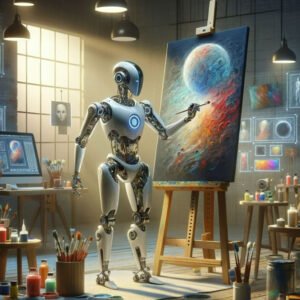By Rajiv Rajkumar Bathija – Visionary with 35 Years of Experience | AI in Art Restoration
Artificial Intelligence (AI) is transforming the field of art restoration, providing new methods to analyze, restore, and preserve historical art pieces. By using advanced machine learning algorithms, AI is enabling art historians and restorers to gain deeper insights into artistic techniques, uncover hidden details, and bring faded masterpieces back to life. In this blog, we explore how AI is being used in art restoration and the valuable contributions it is making to the preservation of cultural heritage.

AI in Art Analysis
– Analyzing Artistic Techniques: AI algorithms can analyze brush strokes, color palettes, and other artistic elements to identify the techniques used by artists. This analysis helps art historians understand the methods and styles employed by different artists and can even be used to attribute unsigned works to specific painters. AI’s ability to recognize patterns that might be imperceptible to the human eye makes it a powerful tool for studying the intricacies of historical art.
– Uncovering Hidden Layers: Many historical art pieces have undergone multiple layers of work, either by the original artist or by restorers over the centuries. AI-powered imaging techniques, such as infrared scanning and X-ray analysis, can uncover hidden layers beneath the surface of a painting. These insights provide a better understanding of the artist’s creative process and can reveal previously unknown details about the artwork.
– Detecting Authenticity: AI is also being used to detect forgeries by analyzing the unique characteristics of an artist’s work. By comparing a suspected forgery with a database of known authentic works, AI can identify inconsistencies that may indicate the piece is not genuine. This capability is invaluable for the art market, helping to maintain the integrity of collections and ensure that only authentic works are bought and sold.
AI in Art Restoration
– Restoring Faded Masterpieces: Over time, many historical art pieces have faded or been damaged due to environmental factors. AI is being used to digitally restore these works, providing a vision of what they originally looked like. Machine learning models can analyze the remaining pigments and use historical data to predict the original colors, allowing restorers to make informed decisions about how to physically restore the piece.
– Automated Retouching: AI-powered tools are also assisting in the retouching process. By analyzing the existing style of a painting, AI can suggest how damaged or missing areas should be retouched to match the original work. This ensures that restorations are as true to the artist’s intent as possible, preserving the authenticity of the piece.
– Filling in the Gaps: Some art pieces have missing sections due to damage or deterioration. AI can help fill in these gaps by using machine learning to predict what the missing elements might have looked like, based on the surrounding context and the artist’s known style. This technique allows restorers to recreate missing portions in a way that blends seamlessly with the original artwork.
AI in Preservation of Art
– Monitoring Environmental Conditions: AI is being used to monitor the environmental conditions in which art pieces are stored. By analyzing data such as temperature, humidity, and light exposure, AI can predict potential risks to the artwork and suggest preventive measures. This proactive approach helps preserve historical art pieces for future generations.
– Digital Archiving: AI is also playing a role in the digital archiving of art. High-resolution images of art pieces can be analyzed and cataloged by AI, creating detailed records that can be used for future reference, research, and restoration efforts. Digital archives help ensure that even if a physical piece is lost or damaged, a detailed record of it will remain.
Ethical Considerations in AI-Driven Art Restoration
While AI offers significant benefits for art restoration, there are also ethical considerations that must be addressed to ensure that restorations are respectful of the original artwork:
1. Maintaining Artistic Integrity
AI can assist in restoring and retouching art, but there is a fine line between restoration and altering the original intent of the artist. It is important for restorers to use AI responsibly, ensuring that any changes made are faithful to the artist’s vision and do not compromise the authenticity of the piece.
2. Bias in AI Models
AI models are trained on existing datasets, which means that any biases present in the data can influence the restoration process. For example, if an AI model is trained primarily on Western art, it may not be as effective in restoring works from other cultures. Ensuring that AI models are trained on diverse datasets is crucial to avoid biased outcomes.
3. Human Oversight
AI is a powerful tool, but it should not replace the expertise of human art historians and restorers. Human oversight is essential to ensure that AI-driven restorations are accurate and that the cultural and historical significance of the artwork is respected. Collaboration between AI and human experts can lead to the best possible outcomes in art restoration.
The Future of AI in Art Restoration
The future of AI in art restoration is full of possibilities. As AI technologies continue to advance, they will provide even more sophisticated tools for analyzing and restoring historical art. The ability to uncover hidden details, restore faded works, and preserve art for future generations will help ensure that our cultural heritage remains accessible and appreciated.
AI has the potential to revolutionize the way we understand and interact with art, providing new insights into the techniques and history of some of the world’s most treasured pieces. By addressing the ethical considerations and ensuring that AI is used responsibly, we can leverage these technologies to enhance our appreciation of art and preserve it for generations to come.
Conclusion
AI is transforming the field of art restoration by providing powerful tools for analyzing, restoring, and preserving historical art pieces. From uncovering hidden layers to restoring faded colors, AI is helping to bring the past to life in ways that were previously impossible. However, it is essential to address ethical challenges related to artistic integrity, bias, and the need for human oversight to ensure that AI-driven restorations are respectful of the original works. By using AI responsibly, we can preserve and celebrate our cultural heritage for future generations.
—
 Follow me for more insights on how emerging technologies are shaping the world.
Follow me for more insights on how emerging technologies are shaping the world.
Feel free to share your thoughts or reach out—I’d love to hear your perspective on how AI is transforming the art world!

